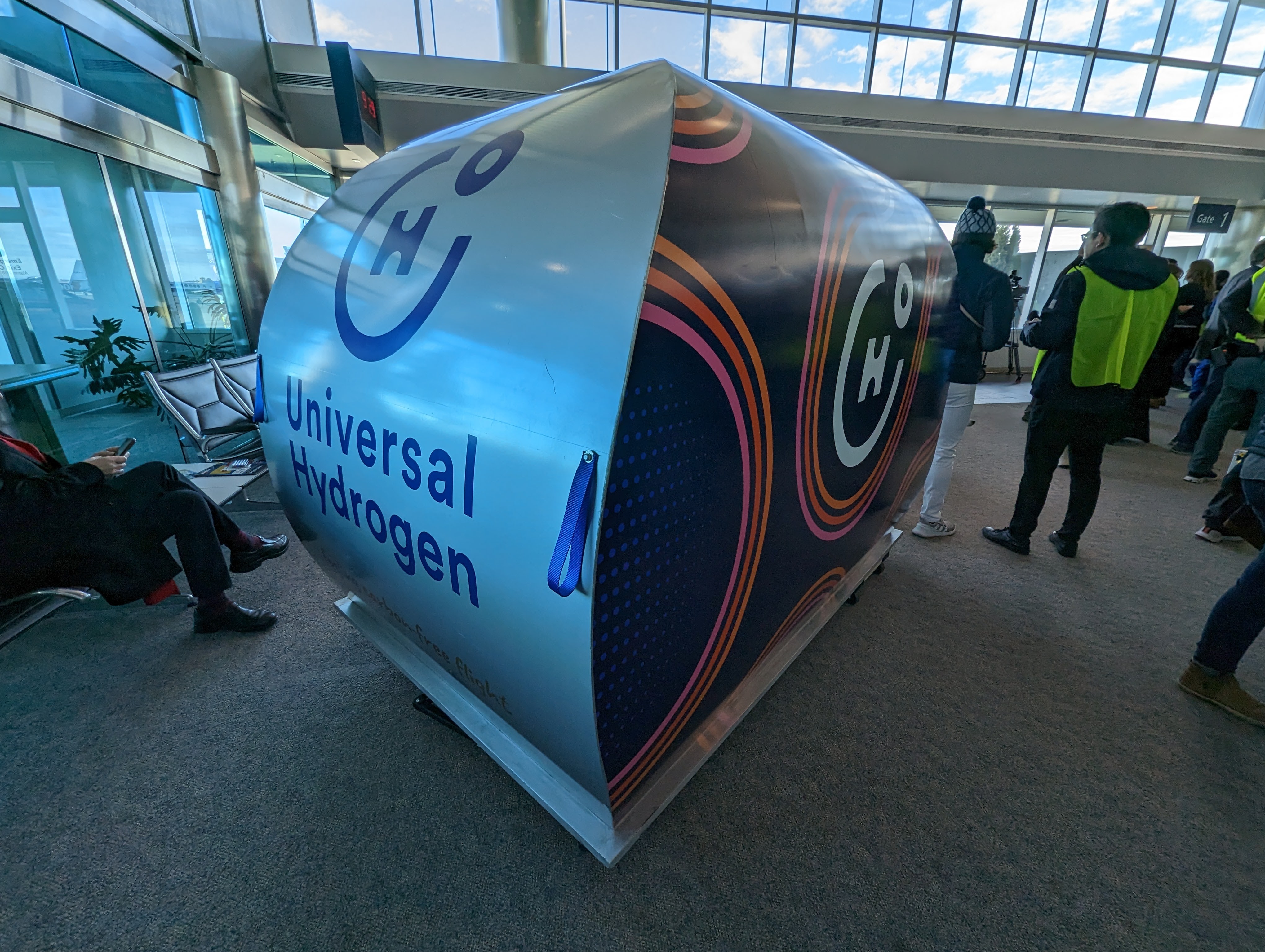As a Universal Hydrogen-branded plane, equipped with the largest hydrogen fuel cell ever to power an aircraft, made its maiden test flight in eastern Washington, co-founder and CEO Paul Eremenko declared the moment the dawn of a “new golden age of aviation.”
The 15-minute test flight of a modified Dash-8 aircraft was short, but it showed that hydrogen could be viable as a fuel for short-hop passenger aircraft. That is, if Universal Hydrogen — and others in the emerging world of hydrogen flight — can make the technical and regulatory progress needed to make it a mainstream product.
Dash-8s, a staple at regional airports, usually transport up to 50 passengers on short hops. The Dash-8 used in Thursday’s test flight from the Grant County International Airport in Moses Lake had decidedly different cargo. The Universal Hydrogen test plane, nicknamed Lightning McClean, had just two pilots, an engineer and a lot of tech onboard, including an electric motor and hydrogen fuel cell supplied by two other startups.
The stripped-down interior contained two racks of electronics and sensors, and two large hydrogen tanks with 30 kg of fuel. Beneath the plane’s right wing, an electric motor from magniX was being driven by the new hydrogen fuel cell from Plug Power. This system turns hydrogen into electricity and water — an emission-free powerplant that Eremenko believes represents the future of aviation.
The fuel cell operated throughout the flight, generating up to 800kW of power and producing nothing but water vapor and smiles on the faces of a crowd of Universal Hydrogen engineers and investors.
“We think it’s a pretty monumental accomplishment,” Eremenko said. “It keeps us on track to have probably the first certified hydrogen airplane in passenger service.”
Aviation currently contributes about 2.5% of global carbon emissions, and is forecast to grow by 4% annually.
Still using jet fuel

The Universal Hydrogen-branded plane also relied on jet fuel. Notice the Pratt and Whitney turboprop engine under one wing. Image Credits: Mark Harris
The test flight, which was a success, doesn’t mean entirely zero-carbon aviation is just around the corner.
Beneath the Dash-8’s other wing ran a standard Pratt and Whitney turboprop engine (notice the difference in the photo above), with about twice as much power as the fuel-cell side. That redundancy helped smooth a path with the FAA, which issued an experimental special airworthiness certificate for the Dash-8 tests in early February.
One of the test pilots, Michael Bockler, told TechCrunch that the aircraft “flew like a normal Dash-8, with just a slight yaw.” He noted that at one point, in level flight, the plane was flying almost entirely on fuel cell power, with the turboprop engine throttled down.
“Until both motors are driven by hydrogen, it’s still just a show,” said a senior engineer consulting to the sustainable aviation industry. “But I don’t want to scoff at it because we need these stepping stones to learn.”
Part of the problem with today’s fuel cells is that they can be tricky to cool. Jet engines run much hotter, but expel most of that heat through their exhausts. Because fuel cells use an electrochemical reaction rather than simply burning hydrogen, the waste heat has to be removed through a system of heat exchangers and vents.
ZeroAvia, another startup developing hydrogen fuel cells for aviation, crashed its first flying prototype in 2021 after turning off its fuel cell mid-air to allow it to cool, and was then unable to restart it. ZeroAvia has since taken to the air again with a hybrid hydrogen/fossil fuel set-up similar to Universal Hydrogen’s, although on a smaller twin-engine aircraft.
Mark Cousin, Universal Hydrogen’s CTO, told TechCrunch that its fuel cell could run all day without overheating, thanks to its large air ducts.
Another issue for fuel cell aircraft is storing the hydrogen needed to fly. Even in its densest, super-cooled liquid form, hydrogen contains only about a quarter the energy of a similar volume of jet fuel. Wing tanks are not large enough for any but the shortest flights, and so the fuel has to be stored within the fuselage. Today’s 15-minute flight used about 16kg of gaseous hydrogen — half the amount stored in two motorbike-sized tanks within the passenger compartment. Universal Hydrogen plans to convert its test aircraft to run on liquid hydrogen later this year.
Making modules
Eremenko co-founded Universal Hydrogen in 2020, and the company raised $20.5 million in a 2021 Series A funding round led by Playground Global. Funding to date is approaching $100 million, including investments from Airbus, General Electric, American Airlines, JetBlue and Toyota. The company is headquartered just up the road from SpaceX in Hawthorne, California, with an engineering facility in Toulouse, France.
Universal Hydrogen will now conduct further tests at Moses Lake. The company will work on additional software development, and eventually convert the plane to use liquid hydrogen. Early next year, the aircraft will likely be retired — with the fuel cell heading to the Smithsonian Air and Space Museum in Washington, DC.
Universal Hydrogen hopes to start shipping fuel cell conversion kits for regional aircraft like the Dash-8 as soon as 2025. The company already has nearly 250 retrofit orders valued at more than $1 billion from 16 customers, including Air New Zealand. John Thomas, CEO of Connect Airlines, which plans to be the first U.S. carrier to use Universal Hydrogen’s technology, said the “partnership provides the fastest path to zero-emissions operation for the global airline industry.”
Universal Hydrogen isn’t just producing the razors — it’s also selling the blades.
Almost all the hydrogen used today is produced at the point of consumption. That’s not only because hydrogen leaks easily and can damage traditional steel containers, but mainly because in its most useful form — a compact liquid — it has to be kept at just 20 degrees above absolute zero, usually requiring expensive refrigeration.
The liquid hydrogen used in the Moses Lake test came from a commercial “green hydrogen” gas supplier — meaning it was made using renewable energy. Only a tiny fraction of hydrogen produced today is made this way.
If the hydrogen economy is really going to make a dent in the climate crisis, green hydrogen will have to become a lot easier — and cheaper — to produce, store and transport.
Eremenko originally started Universal Hydrogen to design standardized hydrogen modules that could be hauled by standard semi-trucks and simply slotted into aircraft or other vehicles for immediate use. The current design can keep hydrogen liquid for up to 100 hours, and he has often likened them to the convenience of Nespresso units. Universal Hydrogen says it has over $2 billion in fuel service orders for the decade ahead.
Prototype modules were demonstrated in December, and the company hopes to break ground later this year on a 630,000-square-foot manufacturing facility for them in Albuquerque, New Mexico. That nearly $400 million project is contingent on the success of a previously unreported $200+ million U.S. Department of Energy loan application. Eremenko says the application has passed the first phase of due diligence within the DOE.
A long runway
Some experts are skeptical that hydrogen will ever make a meaningful dent in aviation’s emissions. Bernard van Dijk, an aviation scientist at the Hydrogen Science Coalition, appreciates the simplicity of Universal Hydrogen’s modules, but notes that even NASA has trouble controlling hydrogen leaks with its rockets. “You still have to connect the canisters to the aircraft. How is that all going to be safe? Because if it leaks and somebody lights a match, that is a recipe for disaster,” he says. “I think they’re also underestimating the whole certification process for a new hydrogen powertrain.”
Even when those obstacles are overcome, there is the problem of making enough green hydrogen using renewable electricity, at a price people will be prepared to play. “If you want to get all European flights on hydrogen, you’d need 89,000 large wind turbines to produce enough hydrogen,” says van Dijk. “They would cover an area about twice the size of the Netherlands.”
But Eremenko remains convinced that Universal Hydrogen and its partners can make it work, with the help of a $3 per kilogram subsidy for green hydrogen in Biden’s Inflation Reduction Act. “Of all the things that keep me awake at night,” he says, “the cost and availability of green hydrogens is not one of them.”

